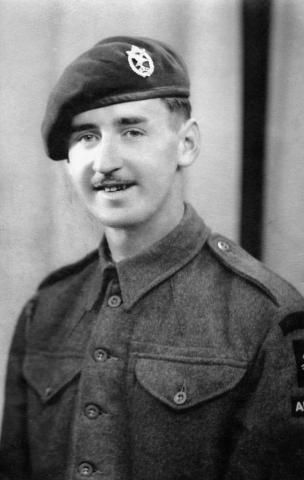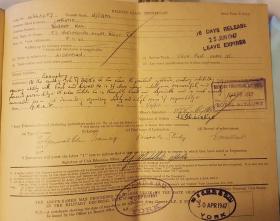Robert Christie was born in Dundee on 22rd August 1923. After leaving school in 1941 he worked for a year as a librarian before enlisting in the army on 5th November 1942. Christie was assigned to the Royal Artillery, in which his father had served in World War 1, and volunteered for airborne service. He joined 1st Airlanding Light Regiment where he trained as a Gun Position Officer’s Assistant.
In May 1943 the regiment sailed for North Africa as part of 1st Airborne Division. They trained in Algeria until September when they disembarked for Italy, arriving in the southern port of Taranto. The regiment fought in the Appenine mountains until the end of January 1944 when they were withdrawn to England, ready for the invasion of North West Europe.
1st Airborne Division was held in reserve after D-Day, before being committed to take and hold the bridge at Arnhem as part of Operation Market Garden. Christie’s 2 Battery flew to Arnhem in the second lift on 18th September. He spent the battle in the command post of 2 Battery’s C Troop in the Oosterbeek perimeter, which was under relentless attack by German forces. Finally, on 25th September 2 Battery was overrun by the Waffen SS. Christie was slightly wounded, but escaped to join other survivors and fight on. That night he was evacuated safely across the Rhine as the remnants of the Division were withdrawn.
Of the regiment’s 372 men who flew to Arnhem only 136 were evacuated. The regiment also lost all its equipment. It therefore spent the rest of the war building up its strength and training the new recruits.
On VE Day 1st Airlanding Light Regiment flew to Stavanger in Norway, as part of Operation Doomsday, to oversee the surrender of German forces. Christie’s C Troop headed for the docks where they took the surrender of the Kriegsmarine naval personnel. As a fluent speaker of German, Christie acted as an interpreter. He also ran the naval telephone switchboard, still operated by German personnel, for the first few days.
The regiment stayed in the Stavanger area for the rest of the summer. In July Christie was one of 15 Allied servicemen chosen to take tea with King Haakon and Crown Prince Olaf at the Royal Palace in Oslo.
In August Christie returned to the Netherlands to take part in the filming of Theirs is the Glory, an account of the Battle of Arnhem that used only veterans of the battle in the cast.
1st Airlanding Light Regiment had been lined up to transfer to the Far East for the proposed invasion of Japan. However, after the Japanese surrender the regiment was disbanded. On completion of his work on the film. Christie joined 53rd Airlanding Light Regiment in Palestine.
Christie was demobbed in April 1947, as a Battery Quarter Master Sergeant. On his return to Scotland he was immediately commissioned into the Territorial Army, serving in 471st (Forth) Heavy Anti-Aircraft Regiment, RA, based in Fife. In 1955 this became 433rd Light Anti-Aircraft Regiment. In 1961 the regiment was converted to a transport role as 433 (Fife) Transport Column, Royal Army Service Corps based in Dunfermline.
In 1965 Christie’s job took him to London and he resigned from the TA as a major. He pursued a successful career in insurance. He returned to Scotland in 1980 and retired in 1986, settling in Perthshire. Christie was active in his local British Legion and also took an active part in the Royal Artillery Historical Society, acting as a guide on tours, and assisting writers. He died in 2000, leaving his wife Dorothy and three sons.
Service History
- 1942
Joined the Royal Artillery.
- 1943
Volunteered for airborne service and joined 1st Airlanding Light Regiment, RA.
- 1943
Algeria, Italy.
- 1944
Returned to England. Battle of Arnhem. Promoted to Lance Bombardier.
- 1945
Norway, Netherlands (filming Theirs is the Glory).
- 1945
Joined 53rd Airlanding Light Regiment, RA. Palestine. Promoted to Bombardier.
- 1946
Promoted to Sergeant, then Battery Quarter Master Sergeant.
- 1947
Demobbed. Commissioned into Territorial Army. 471st (Forth) Heavy Anti-Aircraft Regiment, RA, based in Fife. In 1955 this became 433rd Light Anti-Aircraft Regiment. In 1961 the regiment was converted to a transport role as 433 (Fife) Transport Column, Royal Army Service Corps based in Dunfermline.
- 1955
Regiment becomes 433rd Light Anti-Aircraft Regiment.
- 1961
Regiment converted to a transport role as 433 (Fife) Transport Column, Royal Army Service Corps based in Dunfermline.
- 1965
Resigned from TA (Major).
Created with information and image supplied by James Christie
Read More



Latest Comments
There are currently no comments for this content.
Add Comment
In order to add comments you must be registered with ParaData.
If you are currently a ParaData member please login.
If you are not currently a ParaData member but wish to get involved please register.